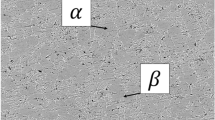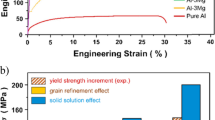Abstract
When machining titanium alloys at cutting speeds higher than 60 m/min using cemented carbide cutting tools, the tool wears out rapidly. With the ever-increasing use of titanium alloys, it is essential to address this issue of rapid tool wear in order to reduce manufacturing costs. Therefore, the intention of this study was to investigate all possible tool wear mechanisms involved when using uncoated carbide cutting tools to machine Ti6Al4V titanium alloy at a cutting speed of 150 m/min under dry cutting conditions. Adhesion, diffusion, attrition, and abrasion were found to be the mechanisms associated with the cratering of the rake surface of the cutting tool. The plastic deformation of the cutting edge was also noticed which resulted in weakening of the rake surface and clear evidence has been presented. Based on this evidence, the process of the formation of the crater wear has been described in detail.
Similar content being viewed by others
References
Ulutan D, Ozel T (2011) Machining induced surface integrity in titanium and nickel alloys: a review. Int J Mach Tools Manuf 51(3):250–280
Bermingham MJ, Kirsch J, Sun S, Palanisamy S, Dargusch MS (2011) New observations on tool life, cutting forces and chip morphology in cryogenic machining Ti-6Al-4V. Int J Mach Tools Manuf 51(6):500–511
Ezugwu EO, Wang ZM (1997) Titanium alloys and their machinability—a review. J Mater Process Technol 68(3):262–274
Venkatesan K, Ramanujam R, Kuppan P (2014) Laser assisted machining of difficult to cut materials: research opportunities and future directions—a comprehensive review. Procedia Eng 97:1626–1636
Palanisamy S, Dargusch MS, McDonald SD, Brandt M, StJohn DH (2007) A rationale for the acoustic monitoring of surface deformation in Ti6Al4V alloys during machining. Adv Eng Mater 9(11):1000–1004
Palanisamy S, McDonald SD, Dargusch MS (2009) Effects of coolant pressure on chip formation while turning Ti6Al4V alloy. Int J Mach Tools Manuf 49(9):739–743
Niu W, Bermingham MJ, Baburamani PS, Palanisamy S, Dargusch MS, Turk S, Grigson B, Sharp PK (2013) The effect of cutting speed and heat treatment on the fatigue life of Grade 5 and Grade 23 Ti-6Al-4V alloys. Mater Des 46:640–644
Budak E, Tunc LT (2010) Identification and modeling of process damping in turning and milling using a new approach. CIRP Ann Manuf Technol 59(1):403–408
Rahman Rashid RA, Sun S, Wang G, Dargusch MS (2012) An investigation of cutting forces and cutting temperatures during laser-assisted machining of the Ti-6Cr-5Mo-5V-4Al beta titanium alloy. Int J Mach Tools Manuf 63:58–69
Dargusch MS, Zhang MX, Palanisamy S, Buddery AJM, StJohn DH (2008) Subsurface deformation after dry machining of grade 2 titanium. Adv Eng Mater 10(1-2):85–88
Trent EM, Wright PK (2000) Metal cutting, 4th edn. Butterworth-Heinemann, USA
Dearnley PA, Grearson AN (1986) Evaluation of principal wear mechanisms of cemented carbides and ceramics used for machining titanium alloy IMI 318. Mater Sci Technol 2(1):47–58
Armendia M, Garay A, Iriarte LM, Arrazola PJ (2010) Comparison of the machinabilities of Ti6Al4V and TIMETAL® 54M using uncoated WC-Co tools. J Mater Process Technol 210(2):197–203
Dan L, Mathew J (1990) Tool wear and failure monitoring techniques for turning—a review. Int J Mach Tools Manuf 30(4):579–598
Hartung PD, Kramer BM, von Turkovich BF (1982) Tool wear in titanium machining. CIRP Ann Manuf Technol 31(1):75–80
Rahman Rashid RA, Bermingham MJ, Sun S, Wang G, Dargusch MS (2013) The response of the high strength Ti-10V-2Fe-3Al beta titanium alloy to laser assisted cutting. Precis Eng 37(2):461–472
Jianxin D, Yousheng L, Wenlong S (2008) Diffusion wear in dry cutting of Ti-6Al-4V with WC/Co carbide tools. Wear 265(11-12):1776–1783
Zhang S, Li JF, Deng JX, Li YS (2009) Investigation on diffusion wear during high-speed machining Ti-6Al-4V alloy with straight tungsten carbide tools. Int J Adv Manuf Technol 44(1-2):17–25
Nabhani F (2001) Machining of aerospace titanium alloys. Robot Comput Integr Manuf 17(1–2):99–106
Komanduri R, Hou ZB (2001) Thermal modeling of the metal cutting process—Part II: temperature rise distribution due to frictional heat source at the tool–chip interface. Int J Mech Sci 43(1):57–88
Komanduri R, Hou ZB (2001) Thermal modeling of the metal cutting process—Part III: temperature rise distribution due to the combined effects of shear plane heat source and the tool–chip interface frictional heat source. Int J Mech Sci 43(1):89–107
Hua J, Shivpuri R (2005) A cobalt diffusion based model for predicting crater wear of carbide tools in machining titanium alloys. J Eng Mater Technol Trans ASME 127(1):136–144
Wang M, Zhang Y (1988) Diffusion wear in milling titanium alloys. Mater Sci Technol 4(6):548–553
Nerz J, Kushner B, Rotolico A (1992) Microstructural evaluation of tungsten carbide-cobalt coatings. JTST 1(2):147–152
Odelros S (2012) Tool wear in titanium machining. Uppsala University
Author information
Authors and Affiliations
Corresponding author
Rights and permissions
About this article
Cite this article
Rahman Rashid, R.A., Palanisamy, S., Sun, S. et al. Tool wear mechanisms involved in crater formation on uncoated carbide tool when machining Ti6Al4V alloy. Int J Adv Manuf Technol 83, 1457–1465 (2016). https://doi.org/10.1007/s00170-015-7668-z
Received:
Accepted:
Published:
Issue Date:
DOI: https://doi.org/10.1007/s00170-015-7668-z




